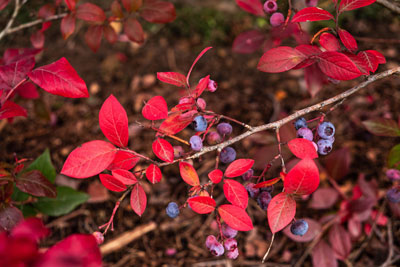
Written by Ingrid Hoff
Did you know blueberries are one of the few naturally occurring blue foods? And that they are a true superfood? Not only tasty but full of antioxidants and nutrients.
Did you also know that they are quite possibly the perfect garden plant? Planting a blueberry bush in your garden means not only do you get a crop of juicy berries but also an attractive shrub with scarlet fall foliage, masses of creamy white bell-shaped flowers in the spring, architectural branches, and shiny oval-shaped bright green leaves.
Also, don’t assume you need a big veggie patch to enjoy your own. A blueberry shrub can be right at home in the middle of an ornamental flower bed, your front yard or in a container on the balcony. They can vary in height from 30cm (1’) to 2m (6.5’) tall, so they fit into a variety of spaces. They are also one of the easiest ways to grow something edible in your space. Just follow these eight simple tips and you’ll have your own bumper crop.

Find the Right Site
Blueberries do best in a sunny spot, they can handle a bit of shade but if you want the best results find your sunniest patch. They are also somewhat shallow rooted (meaning their roots tend to stay near the surface of the soil) so when planting them don’t burry them too deep. You want to make sure that your new shrub is planted at the same height (or mounded up slightly) as the original depth of the rootball.
Know your Soil
Blueberries are an acid loving shrub, that means they need a soil with a low pH. Luckily our soils in the Pacific Northwest already tend towards acidic but if you have any doubts head down to your nearest GARDENWORKS and get a soil pH testing kit. If your soil is not sitting between 4.5 and 5.5 your blueberry will struggle and have stunted growth. There are a number of products you can use to acidify your soil, pelleted Sulphur, specially formulated GARDENWORKS Rhododendron and Azalea Food, and even a little bit of peat moss added to the planting hole can easily set things right. Note: the alkaline soils of the Okanagan will need lots of peat to bring down the pH.
Fertilize, Just a Little
The best times to fertilize your blueberry is once in the early spring and then another small application later as the the berries are developing. However, you want to be careful to avoid high nitrogen fertilizers as this will produce lots of lush green growth but may limit fruit production. Your best option is a specially formulated acid-loving fertilizer. Just make sure to read the application rates as blueberries are not heavy feeders.
Water Well
Because they have a shallow root system blueberries are very sensitive to water conditions. They need well drained soil (no sitting in water for extended periods) but they also need a constant supply of water, especially in the first two years. Don’t let your blueberry dry out.

Mulch
Mulching your blueberry will help retain soil moisture and get rid of any competition (weeds). Lay it on thick, up 8cm (3”), with wood chips, pine needles, leaves or even sawdust. Mulch has the added benefit of increasing the soil organic content, something blueberries benefit from even if they aren’t heavy feeders.
More is Better
Nothing stress first time fruit/berry growers more than the idea of cross pollination. “Wait, how many blueberry shrubs do I have to plant to get berries?” The good news is only one, blueberries are self-fertile, but if you have more than one variety they will produce better. Also, by planting varieties that mature at different times you will have an extended harvest because they will be producing fruit at different times.
Prune
Once established blueberries benefit from regular pruning. For the first 3-4 years let them grow, but after that consider a yearly touch up in the late winter or early spring. Keep in mind the four Ds (dead, diseased, dying or damaged), and remove any spindly or old wood. Branches between 2-6 years are the most productive. By thinning out branches every other year you increase air circulation and decrease the possibility of pests and diseases. Keep in mind that you can safely remove up to 1/3 of the bush each year to invigorate it with new growth.
Harvest
Don’t be fooled into picking a berry that is only just turned purple or you’ll be missing out on sweetness. Take your cue of when to pick when the bush lets the berries go; the sweetest berries will be so ripe they fall off into your hand. Also, never underestimate that birds like blueberries too (you’ve been warned). So, consider a net to make sure you don’t get beaten to the harvest.

Fun facts:
- Bumble bees are the best pollinators for blueberries due to their habit of shaking the flower (the bumble in bumblebee) and that they are better adapted to be active in the cool weather of spring when the blueberries are blooming.
- Indigenous peoples called them star berries because of the perfect five-pointed star shape on the blossom end of the berry.




